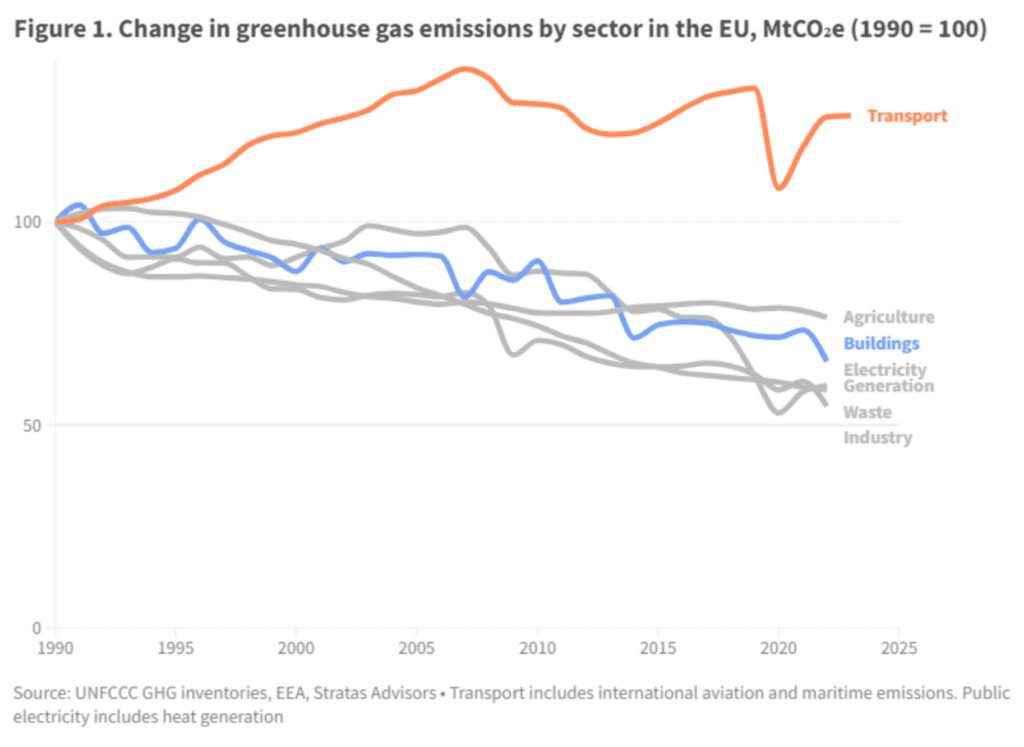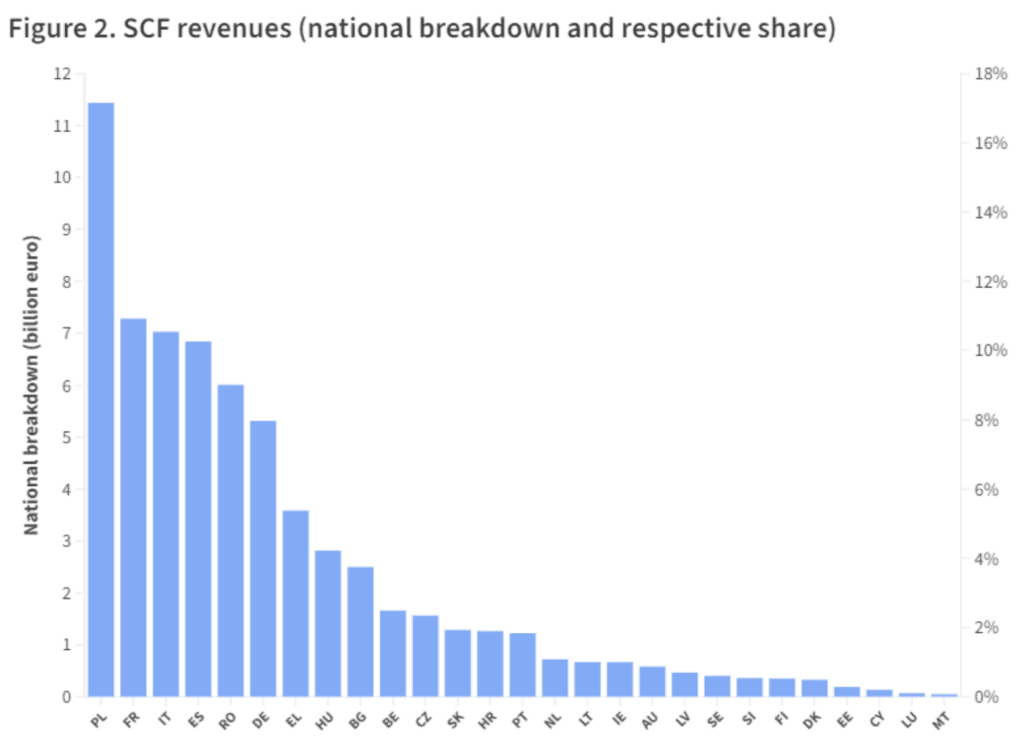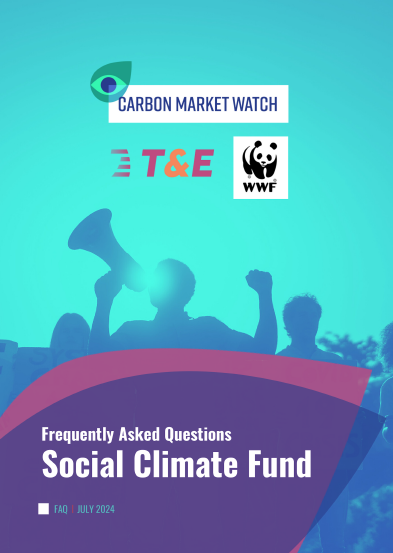The Social Climate Fund (SCF) is the first EU fund developed with the explicit purpose of alleviating potential energy and transport poverty occuring from the transition towards clean mobility, buildings and housing. Our latest FAQ has the answers to everything you always wanted to know about the SCF.
The Social Climate Fund (SCF) has been created to address potential social impacts arising from the ETS2 – the new Emissions Trading System (ETS) that applies a carbon price to buildings and road transport. It is the first EU fund developed with the explicit purpose of alleviating potential energy and transport poverty occuring from the transition towards clean mobility, buildings and housing. From 2026-2032 the fund will channel almost €87 billion in targeted support to all EU member states.
The SCF was created to prevent increases in energy and transport poverty resulting from the introduction of ETS2, which will apply carbon pricing to fuels used in buildings and road transport. It will run as a separate system in parallel to the EU’s existing ETS1 (that covers industry, aviation and shipping), and will begin in 2027.
The ETS2 was introduced due to a lack of progress in reducing emissions across buildings and road transport sectors as outlined in Figure 1, which demonstrates emissions from transport increasing since 1990.

Under the ETS2, fuel suppliers – such as Shell, TotalEnergies and Engie – will be required to purchase permits for the fuel they sell. However, the expectation within the ETS Directive is that suppliers will pass on the cost of these permits to consumers. This would lead to higher fuel costs for heating homes and powering vehicles. When the system starts in 2027, there is an initial soft price ceiling at €45t/CO2.
By decreasing the number of pollution permits for sale, the ETS2 aims to incentivise consumers to make greener choices and lower their emissions over the longer term. A well-functioning ETS2 market should deliver a gradual increase in carbon prices over time and stimulate more investment in zero-emission technology which in turn tightens the cap on emissions. However, as the ETS2 price is levied equally and regardless of income across all member states, it could exacerbate energy and transport poverty.
This is where the SCF comes in. The SCF was created to increase the accessibility and affordability of clean alternatives to lower income groups and micro enterprises against rising energy costs.
Between 2026 and 2032, the SCF will provide a maximum of €65 billion in targeted support for lower income groups and micro enterprises. This will be financed through the auctioning of 50 million allowances under the ETS1, and at least 150 million allowances under the ETS2. In addition, member states are required to co-finance 25% of any measures financed through the EU’s Fund, which increases the total funding to €86.7 billion. To fulfil this obligation, member states can use their share of ETS2 revenues funnelled back directly to them. Total auction revenues are estimated at €195 billion from 2027-2032.

The Social Climate Fund allocates a varied amount to every member state, based on an assessment of need. Factors taken into consideration include the percentage of the population at risk of poverty in rural areas, CO2 emissions from fuel in homes, houses at risk of poverty with arrears on utility bills, total population, and GNI per capita. As a result, Poland (17.6% of the Fund’s budget), France (11.2%), Italy (10.8%), Spain (10.5%), and Romania (9.3%) will receive the most funding.

To access the fund member states must submit Social Climate Plans (SCPs) by June 2025 for review and approval by the Commission, following a mandatory consultation process with stakeholders.
The SCF will begin in 2026, one year prior to the start of the ETS2. Member states must submit Social Climate Plans (SCPs) for review by the European Commission by June 2025. Once submitted, the Commission has two months to seek additional information, if requested and revise the plan if needed. Plans are then assessed based on their relevance, effectiveness, efficiency, and coherence. A final decision is then made within five months of submission. A positive assessment leads to a Commission act outlining all the information related to the implementation of the SCP, including the maximum financial allocation and the national contribution.
The disbursement of the funding is conditional on the achievement of the milestones and targets outlined in the plan. Member states can request payments twice a year, with first payments commencing in 2026. Member states are required to amend their SCPs if they are no longer achievable or need to be significantly adjusted, particularly as a consequence of the ETS2 impact. The Commission can reject the amended plan after giving the member state the opportunity to report its findings and provide explanation for discrepancies.
The Social Climate Plan for each member state should include:
- an estimate of the anticipated effects of price increase resulting from introduction of ETS2, particularly in relation to energy and transport poverty experienced by micro-enterprises;
- estimated number and identification of vulnerable households, micro-enterprises and transport users;
- actionable policies and investments planned to reduce the negative effects of the price increase on these target groups, including temporary income support and long term decarbonisation strategies;
- milestones, targets and indicators to facilitate implementation and completion by mid-2032;
- costs of the plan, and an explanation of how cost efficiency is ensured;
- explanation of how the plan fulfils the ‘do no significant harm’ principle;
- information detailing the public consultation process used to create the plan.
A public consultation with local and regional authorities, representatives of economic and social partners, relevant civil society organisations, youth organisations and other stakeholders must be undertaken. The Plan itself must contain a summary of such consultations, which will be considered in the Commission’s assessment.
Every EU member state is required to complete National Energy and Climate Plans (NECPS) to outline how they will reduce greenhouse gas emissions and improve energy efficiency in order to meet EU 2030 targets. Plans covering the 2021-2030 period were submitted in 2019, and an update covering the first five year period was required by 30 June 2024.
NECP template requirements do not oblige member states to make a comprehensive socio-economic impact assessment of the impacts of climate and energy policies. However, European Commission guidance urges member states to explain the methodology used to prepare Social Climate Plans in the updated NECPs, and to outline how revenue from the SCF will be used to achieve relevant objectives and targets. It is important that NECPs lay a foundation upon which SCPs can develop a strategic approach to using SCF revenue.
However, at the time of writing (June 2024), draft plans are falling short, with each of the 26 submitted NECPs receiving the assessment that it ‘does not contain sufficient information for the preparation of Social Climate Plans.’ In finalising NECPs, member states must better explain the expected social impacts of ETS2, identify potential SCF beneficiaries, outline a policy framework, and explain how consistency between NECPs and SCPs will be ensured.
Additionally, the National Building Renovation Plans (NBRPs), which must be submitted by December 2025 under the Energy Performance of Buildings Directive, must correspond with the SCPs. The NBRPs must include an overview of national building stock, measurable indicators on how the number of people affected by energy poverty will be reduced, and a strategy explaining how 2030, 2040 and 2050 targets relating to renovation of the worst performing residential buildings will be met.
The SCF can be spent on green investments to increase the affordability and accessibility of emissions reductions. Green investments can include energy saving renovations, decarbonisation of heating and cooling systems, and zero/low carbon vehicles. Member states can fashion fiscal incentives or financial support to enhance the affordability of zero- and low-emission vehicles and bicycles, or to modernise infrastructure. The SCF Regulation specifically mentions the development of a second-hand zero-emission vehicles market, incentivising the use of affordable and accessible public transport and supporting private and public entities to provide sustainable mobility on demand, shared mobility services and active mobility options.
A limited amount, up to 37.5% of the fund can fund, can be spent on temporary income support, as many investments, such as the renovation of a home, or the improvement of a public transport line, can take multiple years. Over that time, vulnerable households dependent on public support for those investments are exposed to the carbon price, and monetary support may be needed.
A further 2.5% is available for undertaking public consultation, communications activities, conducting studies or providing technical assistance and capacity building for implementing bodies. This category can cover training to ensure the proper management of the fund and the achievement of its objectives or the creation of ‘one stop shops’ to help citizens overcome difficulties in benefiting from government schemes relating to home renovation. Direct income support is also eligible as many investments, such as the renovation of a home, or the improvement of a public transport line, can take multiple years. Over that time, vulnerable households dependent on public support for those investments are exposed to the carbon price, and monetary support may be needed.
No. The SCF only aims to alleviate new and additional poverty risks from the introduction of the ETS2. Based on today’s figures and prior to its introduction, 41 million people across Europe are unable to adequately heat their homes. The actual number is likely much higher given the complexities of collecting accurate data on energy poverty. Transport poverty indicators are still in their infancy in the EU, with the latest data available from 2014 highlighting that 2.4% of all people in the EU and 5.8% of those at risk of poverty could not afford to use public transport regularly.
Overall, both energy and transport poverty are complex, interlinked with social vulnerabilities such as low income, old age, disability, health and regional disadvantages. The amount available in the Social Climate Fund is insufficient to combat the root causes of energy and transport poverty. But the creation of the first EU-level budget available is a welcome step in the right direction towards a just transition, and the SCPs could inspire consequential national policies that combat poverty beyond the impact of carbon pricing.
Member states had to notify the Commission by the end of the transposition period of the Directive (June 2024) if they have a national carbon tax higher than the ETS2 price and wish to exempt regulated entities from surrendering emission allowances until the end of 2030. In this scenario, the member state cancels the emissions quotas as a result of the opt-out, but is still obliged to allocate the equivalent of the expected revenues towards climate action. Revenues assigned to the SCF will not be affected by the opt-out.







